|
Spanning 1.5 million acres, Everglades National Park offers a diversity of activities, plant life, and wildlife including manatees, alligators, bottlenose dolphin, and visually striking birds. It also houses exotic backcountry camping opportunities and one of the largest mangrove areas in the world.
If adventure is what you're after, you'll be sure to find it at Everglades National Park - ranger programs, bike trails, boating, kayaking and canoeing opportunities abound, not to mention the world class fishing! The question is not, "what is there to do?" but rather "what do I have time to do?" We give you the insider's scoop for getting involved at the park.
The park is open all year and hiking, sightseeing and wildlife watching are the three main activities.
When to Go
Best time to go is in the dry season from December through April. In the winter, average temperatures range from a high of 77°F (25°C) to a low of 53°F (12°C). Summers are hot and humid, with temperatures around 90°F (32°C) and humidity over 90%. Afternoon thunderstorms are common and mosquitoes are abundant. The rainy season is June through October, and mosquito season coincides with the rainy season.
How to Get There
Nearest major airports are Miami and Naples, both around 85 miles from the park.
GPS of Ernest F. Coe Visitor Center: Latitude: 25.395926, Longitude: -80.583939
Directions to the Ernest F. Coe Visitor Center:
From the North: Visitors coming from the Miami area and points north should take the Florida Turnpike (Route 821) south until it ends merging with U.S. 1 at Florida City. Turn right at the first traffic light onto Palm Drive (State Road 9336/SW 344th St.) and follow the signs to the park.
From the South: Visitors driving north from the Florida Keys should turn left on Palm Drive in Florida City and follow the signs to the park.
GPS of Shark Valley Visitor Center: Latitude: 25.760744, Longitude: -80.62578
Directions to the Shark Valley Visitor Center:
Shark Valley Visitor Center is located on Highway 41 (Tamiami Trail / SW 8th St.) 25 miles west of the Florida Turnpike, exit 25A (from the north) and exit 25 (from the south). From the Naples area, take U.S. 41 (Tamiami Trail) approximately 70 miles east to Shark Valley.
GPS of Gulf Coast Visitor Center: Latitude: 25.846595, Longitude: -81.386052
Directions to the Gulf Coast Visitor Center:
The Gulf Coast Visitor Center is located 5 miles south of Highway 41 (Tamiami Trail) on State Road 29, in Everglades City. From Interstate 75 (Alligator Alley), take exit 80 (State Road 29) south and proceed 20 miles to Everglades City. Once in Everglades City, follow the signs to the park. The visitor center is on the right.
What to See and Do
There are plenty of recreational opportunities to enjoy. Below are suggested itineraries to base your visit around.
One-Day Visit
We recommend that you cover the Main Park Road from Ernest F. Coe Visitor Center to Flamingo if you only have one day.
Main Park Road from Ernest F. Coe Visitor Center to Flamingo (76 miles round trip)
Spend your day exploring all of the animal and plant diversity off of Main Park Road as you make your way south to Flamingo. Main Park Road is in many ways the heart of Everglades National Park, and is the most visited section of the park. The road runs roughly North to South, with Flamingo at the southernmost point and the Ernest Coe Visitor Center at the northernmost point, and offers visitors some of the most diverse scenery in Florida.
Begin your visit at the Ernest F. Coe Visitor Center, where you can pick up a map and speak to a ranger, as well as pick up a schedule of ranger-led programs for the day. Travel south along the Main Park Road and visit any or all of the seven interesting stopping off points between the visitor center and Flamingo. Each location has a trail or multiple trails that allow you an up close and personal view of the Everglades plant and animal life, including native bird species, alligator, and mahogany jungles. Expect to spend anywhere between 1.5 - 5 hours exploring this section of the park, based on how many stop off points you visit.
The stop off points are all concentrated along the 38 mile Main Park Road, so all of these locations are located within a short drive from one another. The beauty of the Main Park Road section of the park is that with so many options so close you can keep your plans flexible. If your time is limited, be sure to take a walk on the Anhinga Trail in Royal Palm.
Main Park Road Stop off Points
- The first stop, Royal Palm, is four miles from the Ernest F. Coe Visitor Center and is home to the Anhinga Trail (0.8 miles round trip), which is one of the most popular trails in the park. Although you can do a self-guided tour, we recommend you join a ranger led group as you'll see more wildlife and you'll learn a lot more fascinating facts about the Everglades. Sign up for a ranger led tour at the Royal Palm Visitor's center. The paved trail brings you out into the marsh and has an abundance of wildlife, including alligators, turtles, anhingas, herons, egrets, and many other birds, especially during the winter. The trail starts from the Royal Palm Visitor Center.
Tip: Winter is the best time to visit the Anhinga Trail, as the water level drops and allows you to see much of the wildlife up close.
- Your next stop should be Long Pine Key. This key offers tent camping, pine rocklands, prairies, mahogany hammocks, and man-made lakes, as well as over 28 miles of connecting trails. The Long Pine Key picnic area, 6 miles from the Ernest F. Coe visitor center, provides parking and easy access to the pinelands trail. The pineland trail (0.75 miles) show you the pines and natural habitat that once covered all of South East Florida.
NOTE: Many sections of the pineland trails system are not suitable for hiking during the summer months due to abundant mosquitoes and mud.
A good alternative to the pineland trails system is the Old Ingraham Highway, which offers year-round access. This former road is ideal for extended hikes and bike trips, as it is 22 miles round trip.
- Following Long Pine Key is Pa-hay-okee, which has a boardwalk trail (0.25 miles round trip) that brings you through a sawgrass prairie and looks onto Shark River Slough - the heart of the Everglades. Some visitors think this "river of grass" looks like Africa. Beautiful.
- Mahogany Hammock is next at 19.5 miles. Mahogany Hammock Trail (0.5 miles round trip) will lead you through a tropical mahogany jungle, to the largest mahogany tree in the U.S. The boardwalk trail acts as a bridge, taking you to hardwood hammock tree islands that are in the marsh and are surrounded by sawgrass prairie.
- West Lake (30.5 miles) is the second to last stop on the Main Park Road and it offers West Lake Trail that gives visitors a chance to explore part of the largest protected mangrove forest in the Northern Hemisphere. The half mile long boardwalk trail offers visitors a panoramic view of West Lake.
- The final stop on the Main Road tour is Flamingo. Flamingo overlooks Florida Bay and offers camping accommodations, a visitor center, marina store, food, tour boat, a boat ramp, fuel, bicycle rentals and the coastal prairie trail. The Flamingo area is known for world class fishing where fishing enthusiasts come to catch Tarpon, Snook, Redfish, Seatrout, Snapper, Black drum, and sharks.
If you're staying for two or three days we recommend you stay at the Flamingo Campground. The Electric sites are on a first come first served basis.
Two-Three Day Visit
On your first day complete the one-day visit outlined above. On day two begin your day at the Flamingo Visitor Center.
- The Flamingo Visitor Center lies at the end of the Main Park Road and offers information on all there is to do in Flamingo, including ranger-guided programs, backcountry camping, backcountry permits, canoe and hiking routes. Begin your day here and decide which activity you'd like to do. We recommend a Flamingo Ranger led canoe tours through the surrounding mangroves and can be booked through the visitor's center.
- At the Flamingo Marina sign up for a boat tour. They offer two main tours: 1. Backcountry Boat Tour, 2. Florida Bay Boat Tour.
The backcountry boat tour explores the Whitewater Bay backcountry north of Florida Bay, taking visitors through mangrove forests. Watch for crocodiles which sometimes sun themselves on the banks. The Florida Bay boat tour explores the Florida Bay and offers tour guides who narrate the history of the bay. Allow 2 hours for each tour.
See Where to go canoeing in the Everglades for more information on canoeing in the region.
Stay the night at Flamingo Campground. NOTE: Lodging and restaurant facilities are CLOSED due to Hurricanes Katrina and Wilma of 2005. Plans to rebuild are under review.
Four-Five Day Visit
On your first three days complete the itinerary outlined above. At the end of day three spend the night at Flamingo Campground or Long Pine Key Campground. On day four get up early and drive to the Shark Valley Visitor Center. It's a 2.25 hour, 80 mile drive from Flamingo or 1.25 hour 45 mile drive from Long Pine Key.
- Start your day off with a nice long bicycle ride along Shark Valley's 15 mile round trip Scenic Loop. The Loop takes an average of 2 to 3 hours to complete. While on the Loop be sure to stop off at the 50 foot high observation tower in the midway point. Make sure you bring binoculars as the tower gives a sweeping 360 degree view of the Everglades. You can spot turtles, alligators and wading birds. Bicycle rentals are available from the Tram Tour concession. Phone: (305) 221-8455. Start behind the visitor center and follow the straight West Road
Tip: During the winter migratory birds and different animals are abundant. During the wet season the wildlife spreads out, so you're less likely to see as much wildlife.
Tip: Be prepared for all weather conditions. In the summer months, thunderstorms bring hazardous lightning and temperatures can reach the high 90's. Take plenty of water!
If you're not into riding a bike you can hop a ride on the Shark Valley Tram Tour. The two-hour narrated tram tours are offered along a fifteen-mile loop into the "River of Grass". Tours depart from the benches and provide a great opportunity to see wildlife and learn about the Freshwater ecosystem. Reservations are strongly recommended during the dry, winter season when Everglades National Park is at its busiest. Call (305) 221-8455 for current information.
- Return to US 41 and head towards Carnestown. In Carnestown turn left and head south on Florida 29 to Everglades city. Return to US 41 and head towards Carnestown. In Carnestown turn left and head south on Florida 29 to Everglades city. Everglades City is the launching point for the Gulf Coast section of the park, and is home to the Gulf Coast Visitor Center. It has restaurants and basic amenities. If you're on a four day visit sign up at the visitor center for the two hour Ten Thousand Island Boat Tour or a ranger led canoe trip. The boat tour explores the mangrove islands. You often see dolphins and manatees, ospreys, pelicans and cormorants. Ranger led canoe trips will take you through the mangroves and estuaries and expose you to a variety of wildlife in their natural habitat, including pelicans, great blue and white herons, osprey, dolphin, and occasionally bald eagles.
For a five day visit we suggest you canoe or kayak all the way out to the Gulf of Mexico where you can camp on beaches or take the inland 99-mile Wilderness Waterway, which is a canoe, kayak and boat route that runs from Everglades City all the way to the northwest of Flamingo. Different campground sites are available along the way. As you cruise down the waterway, you'll notice platforms in the middle of the water that look like docks. These are actually called chickees, essentially elevated docks that sit over the water and have a Porta-Potty. You can set your tent up on these platforms and have a unique camping experience over the water.
Tip: If you do get out on the water you should plan your trips with the wind, and also with the tides, as it is a tidally influenced area. You need a canoe or kayak to really enjoy what the Gulf Coast has to offer.
See Where to go canoeing in the Everglades for more information on canoeing in the region.
Campgrounds and RV parks near Everglades City.
Main Activities
Nature walks and talks, hikes, exhibits, wildlife watching, tram tours, sightseeing boats, canoeing, kayaking, motorboats, bicycle rentals, fishing (new a permit)
Ranger Progams
There are numerous Ranger Programs available. They vary depending on the time of year. Each visitor center offers a set of programs.
Park Map
 Park Map Park Map
Visitor and Information Center
Ernest F. Coe Visitor Center
Open all year
Hours: 9 AM to 5 PM
Phone: (305)-242-7700
Ernest F. Coe Visitor Center offers educational displays, orientation films, and informational brochures. In addition, there is often a special collection by local artists on exhibit, and a series of popular walking trails begin only a short drive from the visitor center.
Directions:Visitors coming from the Miami area and points north should take the Florida Turnpike (Route 821) south until it ends merging with U.S. 1 at Florida City. Turn right at the first traffic light onto Palm Drive (State Road 9336/SW 344th St.) and follow the signs to the park. Visitors driving north from the Florida Keys should turn left on Palm Drive in Florida City and follow the signs to the park.
Flamingo Visitor Center
Sometimes closed in the off season (May - November)
Its hours of operations are 9 AM - 4:30 PM (depending on staffing). Lobby is open 24 hours for self-registration for back country sites.
Phone: (239)-695-2945
Flamingo Visitor Center offers educational displays, informational brochures, and backcountry permits. Near the visitor center are campgrounds, a marina and marina store, and several hiking and canoeing trails.
Houseboat, canoe, kayak, bicycle rentals and boat tours are available through the nearby marina store.
Directions: Following the directions for the Ernest. F. Coe Visitor Center and then drive an additional 38 miles through the park to reach the Flamingo Visitor Center. Visitors should expect to drive about an hour through the park before arriving at Flamingo.
Gulf Coast Visitor Center
Open all year
Hours: 9:00 am to 4:30 pm mid April - mid November and 8:00 am to 4:30 pm mid November - mid April
Phone: (239)-695-3311
The Gulf Coast Visitor Center serves as the gateway for exploring the Ten Thousand Islands, a maze of mangrove islands and waterways that extends to Flamingo and Florida Bay. The visitor center offers educational displays, orientation films, informational brochures, and backcountry permits. Boat tours and canoe rentals are available.
Directions: The Gulf Coast Visitor Center is located 5 miles south of Highway 41 (Tamiami Trail) on State Road 29, in Everglades City. From Interstate 75 (Alligator Alley), take exit 80 (State Road 29) south and proceed 20 miles to Everglades City. Once in Everglades City, follow the signs to the park. The visitor center is on the right.
Shark Valley Visitor Center
Open all year
Hours: 9:15 am to 5:15 pm
Phone: (305)-221-8776
Shark Valley Visitor Center offers educational displays, a park video, an underwater camera and informational brochures.
Guided tram tours, bicycle rentals, snacks and soft drinks are available from Shark Valley Tram Tours, Inc.
Directions: Shark Valley Visitor Center is located on Highway 41 (Tamiami Trail / SW 8th St.) 25 miles west of the Florida Turnpike, exit 25A (from the north) and exit 25 (from the south). From the Naples area, take U.S. 41 (Tamiami Trail) approximately 70 miles east to Shark Valley.
Entrance Fees
$10 per private vehicle and $5 per person if the individual is entering by foot, bicycle, or motorcycle. Individuals 16 years old and younger are admitted free of charge. Admission is for seven days and includes unlimited use of the Shuttle.
Everglades National Park Annual Pass is $25, is valid for twelve months from the date of purchase and provides unlimited number of visits.
Entry is free if you own a valid National Parks and Federal Recreational Lands Pass.
There is no fee to access the Gulf Coast Visitor Center and that area of the park.
Pets
Pets are not permitted at backcountry campsites, beaches, or ashore anywhere in the backcountry. Currently pets are permitted in the following areas:
- On roadways open to public vehicular traffic
- In roadside campgrounds and picnic areas
- On the maintained grounds surrounding public facilities and residential areas
- Aboard boats
Health Tips
You'll need insect repellant all year round. Bring plenty of drinking water and sunscreen. Do not swim in the Everglades as alligators, crocodiles and snakes live in ponds and sharks and barracuda in saltwater areas.
Campgrounds
Everglades National Park offers wonderful camping opportunities. While camping is available year-round, persons visiting during the wet season (June through November) should be aware of potentially difficult and uncomfortable conditions. Visitors should also be well-prepared as camping equipment is not available for rent or purchase in the park.
There are two main drive-in campgrounds accessible from the Homestead entrance to the park on the Main Park Road; Long Pine Key campground and Flamingo campground, which both accommodate tents and RV's with a limited number of group sites.
There are a number of ground sites, beach sites, and elevated camping platforms (chickees) available in various locations in the park. Most sites are accessible by canoe, kayak, or motorboat, though a few may be reached by hikers.
NOTE: A backcountry permit is required for all wilderness campsites and issued the day before or day of your trip.
There are also privately run campgrounds near Everglades National Park:
Campgrounds and RV parks near Florida City
Campgrounds and RV parks near Everglades City.
One final point when you go to Everglades National Park be sure to leave reviews and upload photos to our web site to help other campers and RVers understand what your experience was like and whether it would be the right choice for them.
Copyright ©2011 Camping Road Trip, LLC
Find campgrounds and RV parks - Smart Search Now.
Read campground and RV park reviews to help you find the perfect place to stay.
|
|
|
PHOTOS
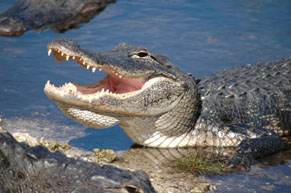 Alligator
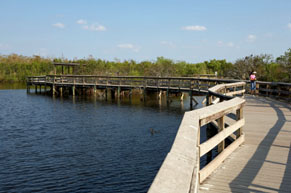
* Anhinga Trail
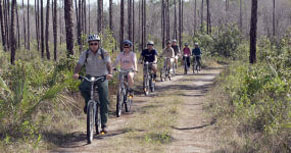 * People bike riding the Long Pine Key Trail
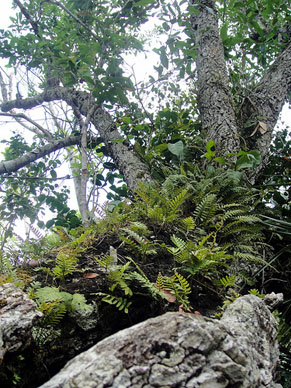 ** Mahogany Tree, Mahogany Hammock Trail
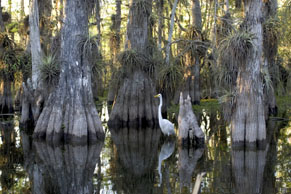 * Great Egret standing in a Cypress Swamp
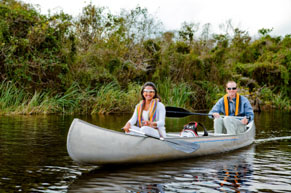 Couple canoeing
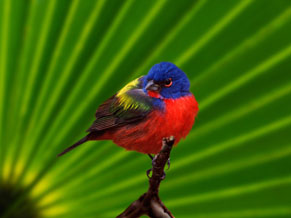 Male Painted Bunting
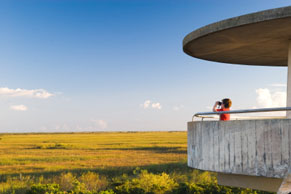
Observation Tower offers stunning views
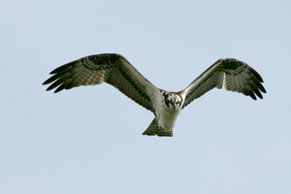 * Osprey hovering
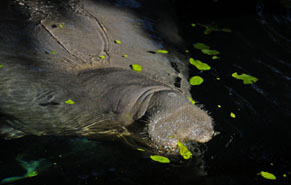 Manatee
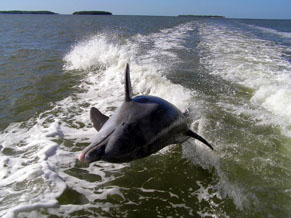 Dolphin joining in on the fun
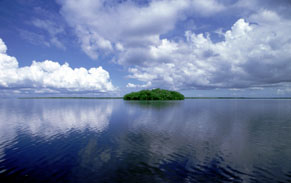 Mangrove island part of Ten Thousand Islands
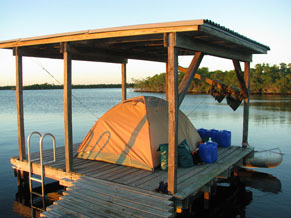 *** Chickee - elevated camping in the Everglades
* Photos courtesy of National Park Service
** Photo courtesy of Matthew Kiefer
*** Photo courtsey of Don Nomazi
|